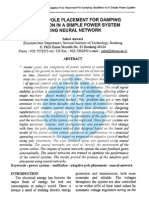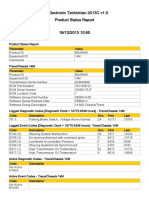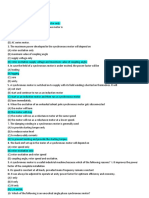Energy Resources and Systems
Uploaded by
Ira CervoEnergy Resources and Systems
Uploaded by
Ira CervoRenewable Energy Systems
ECE 402 / Class 4-A
Topic/Lesson : 2
-----------------------------------------------------------------------------
Energy Resources and Systems
“Engineers and scientists are primarily responsible for the research, development
and design of the equipment that captures energy from renewable and fossil fuel
resources for human use. Given the eventual decline in the availability of fossil
fuel resources, engineers are currently designing technologies for capturing
renewable energy resources that are more efficient, reliable and economically
competitive.”
Scientists define energy as the ability to do “work”. Modern
civilization is possible because people have learned how to change
energy from one form to another and then use it to do work. People
use energy to walk and bicycle, to move cars along roads and boats
through water, to cook food on stoves, to make ice in freezers, to light
our homes and offices, to manufacture products, and to send
astronauts into space.
Where does the energy we use come from? Energy comes
from an energy source.
Energy Sources:
• Fossil fuels – chemical (petroleum, natural gas, coal) energy
• Uranium – nuclear energy
• Biomass – chemical energy
• Geothermal – heat (generated from nuclear processes within the
Earth)
• Hydropower – mechanical energy
• Wind – mechanical energy
• Solar – electromagnetic energy
What do we know about these energy sources? Each of
these sources has a starting form and is converted into a
different form for our convenient use.
Can we use this energy in its form? For example, can sunlight
be directly used to power an electric load? No, a solar photovoltaic (PV)
panel must be used for energy conversion. An Energy System is a
set of conversion technologies that convert energy resources, such as
energy from the sun, into forms that we can utilize for human needs.
Energy system : An energy system is made up of a sequence of
conversions with inputs and outputs that transform an energy resource
into a form usable for human work or heating.
Biomass energy : Energy released from plants (wood, corn, etc.) through
combustion or other chemical process.
Fossil fuel : A non-renewable energy resource that began to form millions
of years ago from the remains of once living plants and animals. Its current
forms include petroleum, coal and natural gas.
Geothermal energy : Heat energy from the Earth.
Hydropower: Transformation of the energy stored in a depth of water into
electricity.
Photovoltaic : A chemical process that releases electrons from a semi-
conductor material in the presence of sunlight to generate electricity.
Solar energy : Energy from the sun; often captured directly as heat or as
electricity through a photovoltaic process.
Uranium : An element that releases heat as it undergoes radioactive
decay.
Wind energy : Energy transferred with the motion of air in the lower
atmosphere that arises from differential heating of the Earth. The energy
in the wind can be extracted as mechanical energy to do work such as
grind grains (a wind mill) or generate electricity (wind turbine).
Renewable energy : Resources, such as wind and water, that can be
recycled or replaced at a rate faster than they are consumed.
Non-renewable energy : Resources, such as fossil fuels, that cannot be
replaced by natural processes at the same rate it is consumed.
Energy Resources Are Available In Our Natural World. Solar
energy is responsible for almost all of these resources. The sun is
responsible for the uneven heating of the Earth that causes wind and
sunlight and plant photosynthesis creates biomass materials such as
wood or corn that we can convert into useable energy. The exceptions
are nuclear and geothermal.
Energy resources that are replenished at the same rate that we use
them are defined as renewable energy resources. Solar, wind,
geothermal and tidal energy are examples of renewable energy.
Biomass can be renewable if we use the plant material at the same rate
that it regrows. But, if we chop down and burn all the trees in a short
period of time, that resource is not considered renewable.
Fossil fuels are also a form of solar energy because they were
generated from biomass materials millions of years ago. They are not
renewable because we are using them at a much faster rate than they
are being regenerated.
Most of our energy is originally derived from the sun.
Environmental impacts differ depending upon the energy source and
conversion process.
Energy sources can be classified as renewable,
nonrenewable or inexhaustible resources.
• An energy source can be considered renewable if it is replenished
within a short period of time.
• Renewable resources include solar, wind (including offshore),
hydro (including micro-hydro), geothermal and biomass.
• Non-renewable energy comes from sources that will run out or
will not be replenished in our lifetimes—or even in many, many
lifetimes.
• Most non-renewable energy sources are fossil fuels: coal,
petroleum, and natural gas.
The world's supply of nonrenewable fossil fuel resources is
limited. Their combustion can negatively affect our
environment. Currently, our society is heavily dependent upon
nonrenewable fossil fuel energy resources, and our lives could
be negatively impacted if the demand for these resources
exceeds the supply.
Different Energy Sources Have Different Costs:
A system is made up of a sequence of conversions. A basic
description of an energy conversion is: Energy from a source
provides input to another system component, which
converts the form and/or state of energy and provides
output to another system component.
In the conversion of energy, a significant fraction of that
energy can be "lost" from the system (in the form of heat,
sound, vibration, etc.). This energy is not really lost, it is just
not converted to the desirable or intended form.
The components of an energy system must work together to
transform energy into a form that can be used in our society.
Systems can be divided into inputs, processes, outputs and
feedback.
Summary:
The term “energy systems” usually describes the set of
production, transformation, transport and distribution
processes of energy sources. Energy systems usually are
very complex and call for knowledge deriving from all scientific
fields to be developed and managed. Although using the
energy available in our homes is easy (we push a button and
the light is switched on), producing that energy and conveying
it into our homes is an extremely difficult and complex task.
Energy has by now become an inseparable partner of human
beings, who use it at any time every day in all their activities.
To ensure the possibility of benefiting from that resource in a
simple, stable and constant way, mankind had to conduct
studies and research for a long time, and only during the last
decades of the 19th century did many nations, but not all,
succeed in developing “energy systems” ensuring the quality
and quantity of energy necessary for development.
------------------------------------------------------------------------------
You might also like
- Last Push Physical Science Paper 2 Sep 2018100% (1)Last Push Physical Science Paper 2 Sep 201887 pages
- Space Shuttle Main Engine The First Ten Years - 1No ratings yetSpace Shuttle Main Engine The First Ten Years - 16 pages
- 1 ELET 414 Renwable Energy Resources W1 W3No ratings yet1 ELET 414 Renwable Energy Resources W1 W344 pages
- Resources of Energy3rdStage (1st Term) PDFNo ratings yetResources of Energy3rdStage (1st Term) PDF75 pages
- Renewable Energy Is Energy Which: Enewable Nergy EsourcesNo ratings yetRenewable Energy Is Energy Which: Enewable Nergy Esources4 pages
- Module Four Renewable Energy Sources PDFNo ratings yetModule Four Renewable Energy Sources PDF30 pages
- Contents: They Are As Follow 1. Abstract 2. Introduction To Renewable Energy Resources 3. Selected Resource & Reasoning 4. Calculations & Justification 5. Conclusion 6. References 1. AbstractNo ratings yetContents: They Are As Follow 1. Abstract 2. Introduction To Renewable Energy Resources 3. Selected Resource & Reasoning 4. Calculations & Justification 5. Conclusion 6. References 1. Abstract8 pages
- Earth Science Week 3 What You Are Expected To Learn:: Chapter 3: Energy ResourcesNo ratings yetEarth Science Week 3 What You Are Expected To Learn:: Chapter 3: Energy Resources8 pages
- Keywords: Green Energy Technology, Renewable Resources, Sustainable Energy, EnergyNo ratings yetKeywords: Green Energy Technology, Renewable Resources, Sustainable Energy, Energy29 pages
- Do Work.": Thomas Young - The First To Use The Term "Energy" in The Modern SenseNo ratings yetDo Work.": Thomas Young - The First To Use The Term "Energy" in The Modern Sense16 pages
- (Army)CVE 105 MAN AND HIS ENERGY RESOURCESNo ratings yet(Army)CVE 105 MAN AND HIS ENERGY RESOURCES6 pages
- Renewable source of Energy- TopLogic NotesNo ratings yetRenewable source of Energy- TopLogic Notes5 pages
- Environment Awareness: Applications of Renewable Energy100% (1)Environment Awareness: Applications of Renewable Energy5 pages
- Chapter 1-Basic Energy Concepts-HulscherNo ratings yetChapter 1-Basic Energy Concepts-Hulscher17 pages
- Reading Comprehension Exercise Subjects: Geography & English Sources of Renewable Energy"No ratings yetReading Comprehension Exercise Subjects: Geography & English Sources of Renewable Energy"4 pages
- Group 1: Daizy Fabro Katrina Bautista Angel Faith de Guzman Yashmen Javier Christine EstebanNo ratings yetGroup 1: Daizy Fabro Katrina Bautista Angel Faith de Guzman Yashmen Javier Christine Esteban16 pages
- Energy: Work Heat Kinetic Mechanical Energy Light Potential Energy ElectricalNo ratings yetEnergy: Work Heat Kinetic Mechanical Energy Light Potential Energy Electrical24 pages
- Chapter-1: 1.1 Introduction To Energy NeedsNo ratings yetChapter-1: 1.1 Introduction To Energy Needs75 pages
- Renewable Energy Sources - Wave, Geothermal and Biomass Energy Edition : Environment Books for Kids | Children's Environment BooksFrom EverandRenewable Energy Sources - Wave, Geothermal and Biomass Energy Edition : Environment Books for Kids | Children's Environment BooksNo ratings yet
- 01 - Lecture - Outline CONCEPTS OF MOTIONNo ratings yet01 - Lecture - Outline CONCEPTS OF MOTION94 pages
- A Performance Evaluation of Linux Containers On Similar ARM BasedNo ratings yetA Performance Evaluation of Linux Containers On Similar ARM Based7 pages
- Removal of High Frequency Noise From ECG Signal Using Digital IIR Butterworth FilterNo ratings yetRemoval of High Frequency Noise From ECG Signal Using Digital IIR Butterworth Filter4 pages
- Communication Aids and Strategies Using Tool of Technology: Cervo - Hucamis - MuerongNo ratings yetCommunication Aids and Strategies Using Tool of Technology: Cervo - Hucamis - Muerong27 pages
- Experiment No.1: Introduction To Lti Representation and Transfer Function ModelNo ratings yetExperiment No.1: Introduction To Lti Representation and Transfer Function Model7 pages
- Application of Butterworth Filter in Display of Radar Target TrackNo ratings yetApplication of Butterworth Filter in Display of Radar Target Track3 pages
- A Novel Modulator: Nakul Birla', Nishit Gautam2, Jasmeen Patel3, Pavithra Balaji4No ratings yetA Novel Modulator: Nakul Birla', Nishit Gautam2, Jasmeen Patel3, Pavithra Balaji44 pages
- Siemens Energy Optimises Power Transformers With The Aid of 3D EM SimulationNo ratings yetSiemens Energy Optimises Power Transformers With The Aid of 3D EM Simulation6 pages
- Adaptive Placement For Damping Oscillation Iin A Simple Power System Using Neural NetworkNo ratings yetAdaptive Placement For Damping Oscillation Iin A Simple Power System Using Neural Network6 pages
- Green Areas and Urban Heat Island in A Tropical CityNo ratings yetGreen Areas and Urban Heat Island in A Tropical City12 pages
- Objective Type Questions Chapter # 1 The Scope of Physics: Compiled By: Faizan AhmedNo ratings yetObjective Type Questions Chapter # 1 The Scope of Physics: Compiled By: Faizan Ahmed2 pages
- XXX Geothermal Exploration Best Practices XXXNo ratings yetXXX Geothermal Exploration Best Practices XXX156 pages
- Fig.4.9 Fixing Operating Point, (BM, HM)No ratings yetFig.4.9 Fixing Operating Point, (BM, HM)27 pages
- Organograms - All Directorates IOM 17.8.2018No ratings yetOrganograms - All Directorates IOM 17.8.20187 pages
- Cat Electronic Technician 2013C v1.0 Product Status ReportNo ratings yetCat Electronic Technician 2013C v1.0 Product Status Report10 pages
- Competition Tribunal On Sasol and EngineNo ratings yetCompetition Tribunal On Sasol and Engine214 pages
- Interpretation of Magnetic Resonance Imaging of Orbit: Simplifi Ed For Ophthalmologists (Part I)No ratings yetInterpretation of Magnetic Resonance Imaging of Orbit: Simplifi Ed For Ophthalmologists (Part I)7 pages
- SNL Brayton Experiment Data Report 6 1 2006No ratings yetSNL Brayton Experiment Data Report 6 1 200680 pages
- Renewable Energy Is Energy Which: Enewable Nergy EsourcesRenewable Energy Is Energy Which: Enewable Nergy Esources
- Contents: They Are As Follow 1. Abstract 2. Introduction To Renewable Energy Resources 3. Selected Resource & Reasoning 4. Calculations & Justification 5. Conclusion 6. References 1. AbstractContents: They Are As Follow 1. Abstract 2. Introduction To Renewable Energy Resources 3. Selected Resource & Reasoning 4. Calculations & Justification 5. Conclusion 6. References 1. Abstract
- Earth Science Week 3 What You Are Expected To Learn:: Chapter 3: Energy ResourcesEarth Science Week 3 What You Are Expected To Learn:: Chapter 3: Energy Resources
- Keywords: Green Energy Technology, Renewable Resources, Sustainable Energy, EnergyKeywords: Green Energy Technology, Renewable Resources, Sustainable Energy, Energy
- Do Work.": Thomas Young - The First To Use The Term "Energy" in The Modern SenseDo Work.": Thomas Young - The First To Use The Term "Energy" in The Modern Sense
- Environment Awareness: Applications of Renewable EnergyEnvironment Awareness: Applications of Renewable Energy
- Reading Comprehension Exercise Subjects: Geography & English Sources of Renewable Energy"Reading Comprehension Exercise Subjects: Geography & English Sources of Renewable Energy"
- Group 1: Daizy Fabro Katrina Bautista Angel Faith de Guzman Yashmen Javier Christine EstebanGroup 1: Daizy Fabro Katrina Bautista Angel Faith de Guzman Yashmen Javier Christine Esteban
- Energy: Work Heat Kinetic Mechanical Energy Light Potential Energy ElectricalEnergy: Work Heat Kinetic Mechanical Energy Light Potential Energy Electrical
- Green Energy 101: A Guide to Home Solar & Wind PowerFrom EverandGreen Energy 101: A Guide to Home Solar & Wind Power
- Renewable Energy Sources - Wave, Geothermal and Biomass Energy Edition : Environment Books for Kids | Children's Environment BooksFrom EverandRenewable Energy Sources - Wave, Geothermal and Biomass Energy Edition : Environment Books for Kids | Children's Environment Books
- A Performance Evaluation of Linux Containers On Similar ARM BasedA Performance Evaluation of Linux Containers On Similar ARM Based
- Removal of High Frequency Noise From ECG Signal Using Digital IIR Butterworth FilterRemoval of High Frequency Noise From ECG Signal Using Digital IIR Butterworth Filter
- Communication Aids and Strategies Using Tool of Technology: Cervo - Hucamis - MuerongCommunication Aids and Strategies Using Tool of Technology: Cervo - Hucamis - Muerong
- Experiment No.1: Introduction To Lti Representation and Transfer Function ModelExperiment No.1: Introduction To Lti Representation and Transfer Function Model
- Application of Butterworth Filter in Display of Radar Target TrackApplication of Butterworth Filter in Display of Radar Target Track
- A Novel Modulator: Nakul Birla', Nishit Gautam2, Jasmeen Patel3, Pavithra Balaji4A Novel Modulator: Nakul Birla', Nishit Gautam2, Jasmeen Patel3, Pavithra Balaji4
- Siemens Energy Optimises Power Transformers With The Aid of 3D EM SimulationSiemens Energy Optimises Power Transformers With The Aid of 3D EM Simulation
- Adaptive Placement For Damping Oscillation Iin A Simple Power System Using Neural NetworkAdaptive Placement For Damping Oscillation Iin A Simple Power System Using Neural Network
- Green Areas and Urban Heat Island in A Tropical CityGreen Areas and Urban Heat Island in A Tropical City
- Objective Type Questions Chapter # 1 The Scope of Physics: Compiled By: Faizan AhmedObjective Type Questions Chapter # 1 The Scope of Physics: Compiled By: Faizan Ahmed
- Cat Electronic Technician 2013C v1.0 Product Status ReportCat Electronic Technician 2013C v1.0 Product Status Report
- Interpretation of Magnetic Resonance Imaging of Orbit: Simplifi Ed For Ophthalmologists (Part I)Interpretation of Magnetic Resonance Imaging of Orbit: Simplifi Ed For Ophthalmologists (Part I)






































































































